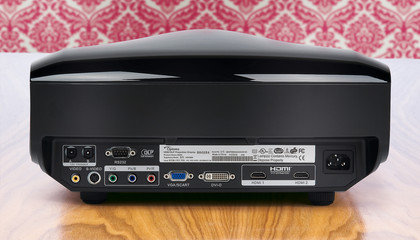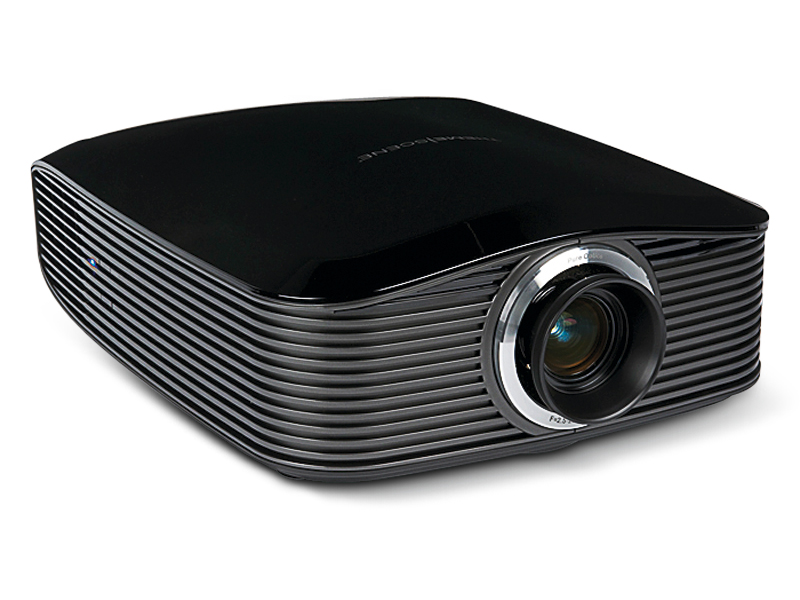TechRadar Verdict
It's not perfect, but then what is? This Optoma is still a damn fine projector
Pros
- +
Good blacks levels
- +
Impressive colour performance
- +
Easy to set up
Cons
- -
Some dynamic iris noise
- -
Some DLP rainbow effect
Why you can trust TechRadar
The Optoma Themescene HD82 is a mid-priced projector designed to deliver a truly cinematic experience, and they're using some pretty strong words. So can it live up to its billing?
To qualify as a paradigm shift, the HD82 would have to deliver technology and performance so stunning that it would become a new standard by which all other home cinema projectors would be measured.
It certainly has a great pedigree; Optoma is making in-roads into the projector market in every area from the tiny pocket Pico to the affordable GT-7000 for game players. Previous home cinema projectors such as the HD80 have set a high standard, so the HD82 would have to be something really special to hold its end up.
Certainly the claims for the HD82 make impressive reading. It's powered by Texas Instruments' DLP DarkChip3 DMD technology, and has a claimed 20,000:1 contrast ratio. New technologies include a motion control video-processing system designed to deliver smooth HD playback; PureEngine and PureMotion technologies using a frame insertion system; and a new and highly flexible lens arrangement.
In appearance, the HD82 is certainly an improvement on earlier generations. Adopting a centre-lens layout, it's not small or light, and weighs around 8kg, but it is sleek, elegant, glossily black, and devoid of ugly panel controls. Mind you, Optoma realises this could be inconvenient should you lose or damage the main remote, so includes a mini-remote, which clips magnetically to the rear of the projector.
The main remote is similar to previous models, with backlit keys and a fairly obvious layout.
Spec respect
The HD82's connection panel is as well-specified as you could desire. You get two HDMI 1.3 inputs that support DeepColor, a DVI socket that supports HDCP, component YCbCr/YPbPr phono sockets, an S-video input, a composite video input, an RS-232 control socket, and not one, but two +12V trigger sockets.

Plenty of connections then, but more significant are the lens shift functions. Under the case are three wheels that control the 1.5x lens zoom, and vertical and horizontal shift, along with a manual focus ring. Between these, it should be possible to install the HD82 without difficulty in a wide range of environments – and the menu system offers all sorts of installation options, too.
By avoiding digital keystoning, the PureShift system ensures a uniform quality for all the image. Projection range is from around 1.5m-12.5m, with an image size of 0.76m-7.67m (diagonal, for a 16:9 image). An anamorphic lens is an optional extra, and one of the 12V trigger sockets can be programmed to activate a lens 'sled'.
Another new technology – which accounts for a significant portion of the case – is a twisty-turny system of cooling airducts. With much of the air-cooling done passively, Optoma can reduce the work done by the cooling fan, and hence the noise it produces. Clever, yes?
At around 26dB it's a big improvement on previous DLP models, though still not the quietest around. Standby power consumption has been reduced too, from around 10W to under 1W – of course, that's to be expected with the new EU regulations soon to come into effect.
Real test
Given that the HD format sets a minimum standard for resolution, the real tests of a projector are now its brightness, black levels and colour reproduction. Optoma makes some extraordinary claims for the contrast ratio of the HD82, and while they might be achieved under exacting manufacturers' laboratory conditions, few of us live in laboratories, so we have to apply some real-world standards as well.
In my viewing tests, the Optoma's best contrast performance was (not surprisingly) achieved with the Dynamic Iris system switched on. Watching the Walt Disney Blu-ray of Prince Caspian, I was certainly impressed by terrific amounts of detail, extremely rich colours and strong contrasts (the projector defaults to its Cinema preset mode, which slightly over-emphasises brightness and colour, but it worked for this sort of material).
Pure and simple
As for motion handling, a scene where the Narnia children are observing the preparations of the enemy army illustrates the effectiveness of the HD82's Pure Motion system. This works much like a TV's 100Hz function, interpolating extra frames to smooth out motion blur.
With a split-screen function to demonstrate its effect, it's easy to see the benefits here. Look at the siege ladders as the camera pans across. With Pure Motion switched off, the uprights blur as the camera pans. With it switched on, they're much smoother and more detailed.
Of course, there's a price to be paid, as there is using a TV's 100Hz function. The danger is that the frame interpolation will create unwanted artefacts, particularly on moving objects. Fortunately, the level of Pure Motion processing can be set, so you can adjust it to suit you.
The HD82 has effective Noise Management functions, which clean up video sources a lot, reducing movement and smoothing out areas of colour, though at the expense of introducing some aliasing.
Prince Caspian's cave sequence – where bright torches stand out against a totally black background – also shows the effectiveness of the HD82's Dynamic Iris system. Sadly though, the iris is perfectly audible above quiet dialogue. But switch it off, and the contrast performance visibly drops with the blacks losing something of their depth.
Another problem shown by Prince Caspian's cave sequence is the DLP rainbow effect. I hadn't really noticed it while watching evenly-lit scenes, but the torchlight made it shimmer. The six-segment design of the colour-wheel does something to reduce the effect, and it's not the worst I've seen, but as with any DLP projector, if you're prone to it, you should get a demo of the HD82 before you buy, and check out what rainbowing you can see.
If it sounds as if I have reservations about the HD82, it's only because Optoma's claims for it have to be taken with a pinch of salt. For in the real world, it's extraordinarily easy to set up, packed with helpful functions, nice-looking, and a top performer. You'll be hard pushed to find anything significantly better for the money, though there is competition around this price from the likes of Epson and InFocus.
Unlike Darwinism, the theory of relativity, or quantum mechanics, the HD82 does not represent a paradigm shift. But it is a worthy development of a distinguished product line, and a darned good projector.
Follow TechRadar Reviews on Twitter: http://twitter.com/techradarreview
